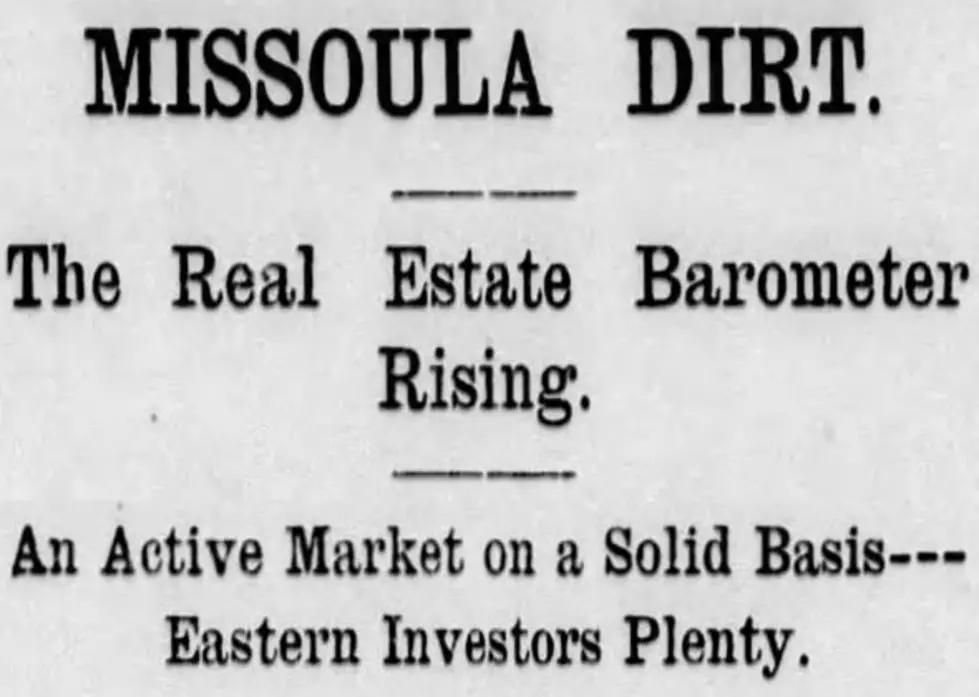
Harmon’s Histories: Missoula’s 1890 real estate boom rivaled that of today
Missoula dirt. It’s valuable and worth investing in, according to the front page story in the Missoula Weekly Gazette in April of 1890.
The headlines trumpeted: “The real estate barometer is rising” and “Eastern investors plenty.”
Handsome profits were already being reported. “One party who bought three lots on the south side three weeks ago received an offer of $200 for his bargain. The gentleman, a shrewd and far-seeing merchant, declined the offer.”
Helena capitalists, especially those with the given name John, saw the opportunities in Missoula real estate.
John S. Miller invested $6,000 in land deals. John Bean “bought eleven lots in Cook’s addition, several lots not far from the bridge on the south side.” John Horsky, a Helena brewer, bought four lots.
Not unlike modern times, “To every house completed there are dozens of applicants and many new structures are contracted before the foundations are in.”
For renters, it was worse. “It is almost impossible to rent a comfortably large house anywhere within the city limits.”
Missoula, with its moderate, inviting climate, had the prospect of becoming “one of the largest and most important cities in Montana (and was) the leading city in all business and manufacturing enterprises of western Montana and eastern Idaho.”
The Gazette called on those with investment capital to take a good look at Missoula.
“There could be no more profitable investment than the building of good houses in this city for rent, and the board of trade would do well to set that fact before the country as widely as possible,” the newspaper proclaimed.
Real estate brokers Cornish & Winstanley advertised city and country property for sale on favorable terms, as did McConnell, Cook & Company.
A month later, in May 1890, the Gazette reported, “Many buildings that were a week ago only in their night shirts are now in presentable shape.”
“It has been a great week for contractors. They have had most excellent weather and a fair supply of material. The greatest difficulty our builders find is that they cannot receive building materials fast enough, showing that lumbering mills and stone quarries are taxed to their utmost capacities.”
A number of commercial buildings downtown were nearing completion, including the Missoula Mercantile block, the First National Bank building and the Rogers Hotel.
The market softened a bit in July and August but picked up again in September 1890. E. Rutherford of the real estate firm Rutherford & Tower told the Gazette, “I confidently expect our city to rise to a population of 20,000 within the next five years.” The current population was around 7,000.
R. Prescott, another local realty agent, agreed saying, “We are bound to be the metropolis of the northwest in a very few years, and without any undesirable hue and cry to accompany it.”
It was forecast that at least 50 new homes would be built in Missoula in 1890. Total construction was projected to be something close to $2 million.
The building boom was unprecedented in Missoula history.
In addition to residential development, commercial construction was at an all-time high. Nearing completion were the Higgins Western Bank and the Western Montana National Bank.
“The new First National Bank building at the corner of Front Street and Higgins Avenue” was valued at $100,000. The Missoula Mercantile block planned $60,000 in additions and improvements. The new Kennedy Hotel was valued at $80,000.
The Gazette summed it all up, writing, “This short sketch, while being imperfect, will give outsiders a faint idea of what kind of a town Missoula is.”
Jim Harmon is a longtime Missoula news broadcaster, now retired, who writes a weekly history column for Missoula Current. You can contact Jim at harmonshistories@gmail.com. His best-selling book, “The Sneakin’est Man That Ever Was,” a collection of 46 vignettes of Western Montana history, is available at harmonshistories.com.
